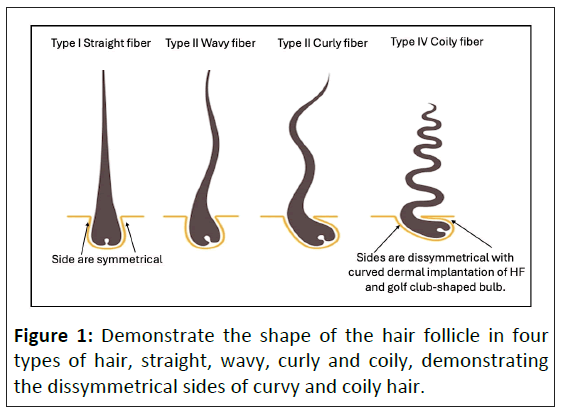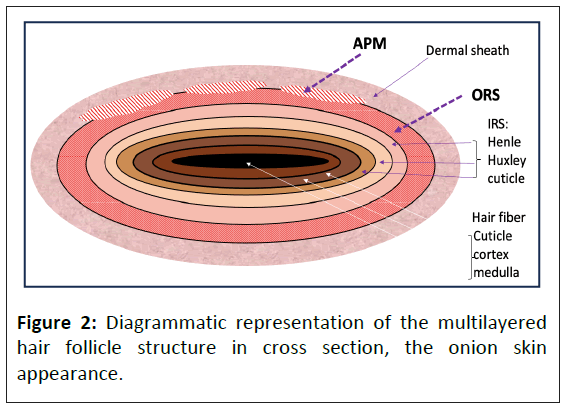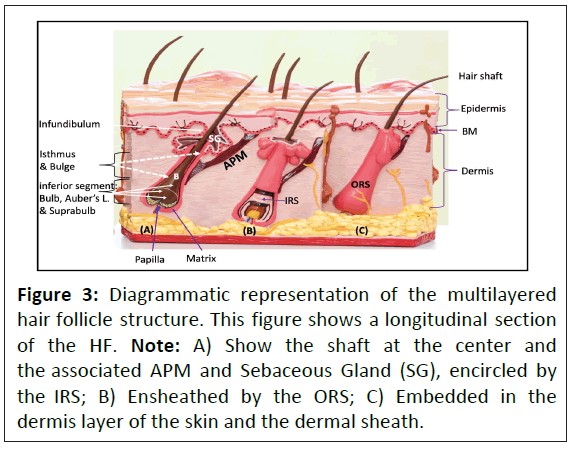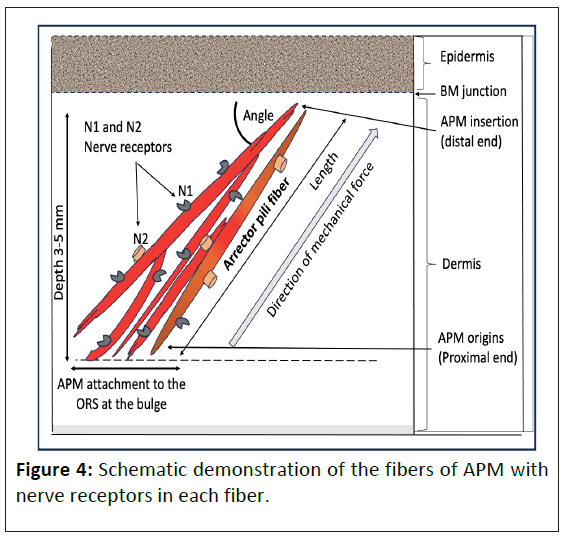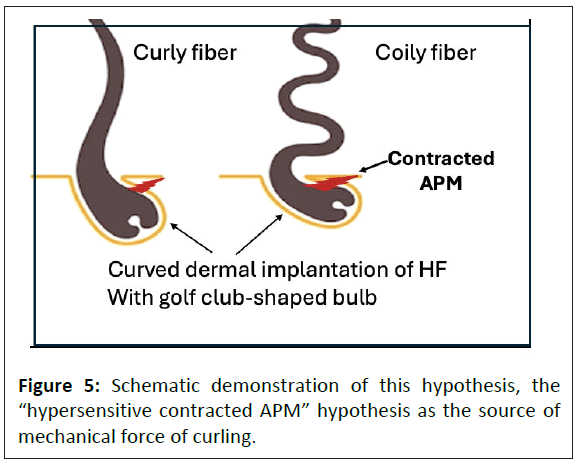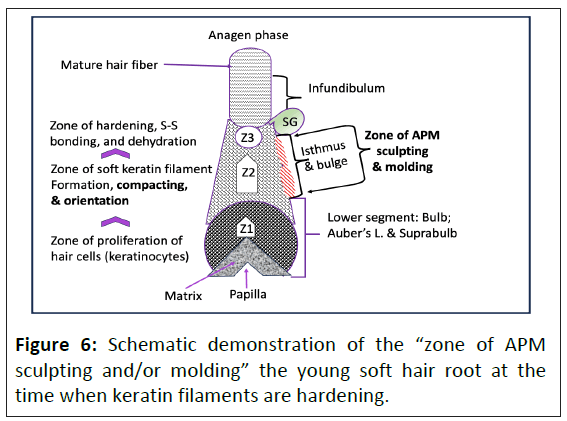ISSN : 2393-8862
American Journal of Pharmacology and Pharmacotherapeutics
Curly Hair Follicle is Sculpted by a Contracted Arrector Pili Muscle. A Hypothesis with Treatment Implications
Nedaa Al Jasim*
Apex Medical Device Design Company, Dublin, Ohio, USA
- *Corresponding Author:
- Nedaa Al Jasim
Apex Medical Device Design Company, Dublin, Ohio,
USA,
E-mail: nedaa.aljasim@gmail.com
Received date: September 26, 2024, Manuscript No. IPAPP-24-19712; Editor assigned date: September 30, 2024, PreQC No. IPAPP-24-19712 (PQ); Reviewed date: October 14, 2024, QC No. IPAPP-24-19712; Revised date: October 21, 2024, Manuscript No. IPAPP-24-19712 (R); Published date: October 28, 2024, DOI: 10.36648/2393-8862.11.S1.01
Citation: Al Jasim N (2024) Curly Hair Follicle is Sculpted by a Contracted Arrector Pili Muscle: A Hypothesis with Treatment Implications. Am J Pharmacol Pharmacother Vol.11 No. S1: 01.
Abstract
The enormous diversity of hair fibers found in human population is striking, while the basic structure of human fibers is often the same! But why do some fibers curl? Curling is related to the machinery and processes that produce different keratin filament orientation in relation to the axis of hair growth, influenced by developmental and molecular control. It is established that a curly hair shaft is produced by a curved hair follicle that have an angulated dermal implantation, with a bulb bent in the shape of golf club, while the outer root sheath is dissymmetrical have an outer side that is convex bulging and thin and a concave side in which the cells express alpha-smooth muscle protein reflecting internal mechanical force. Yet, the exact cause of hair curling is not known. All the previous studies were short of impacting curly hair treatment. My hypothesis is that the curling mechanical force is generated by a hypersensitive contracted Arrector Pili Muscle (APM) of the hair follicle. In curly hair, each APM fiber is shortened pulling its attachment spot upward towards the epidermis and obliquely or laterally curling the outer root sheath to produce the curved follicle described above. This contraction has the influence at a time when the young hair root is being formed and keratin microfibrils are being oriented and packed. APM is a multi-unit muscle wherein each fiber contracts independently to create the enormous diversity of curly hair types. APM contraction can be modulated by oral administration of selective smooth muscle relaxing treatment that relax the curved follicle from within. Further studies are needed to confirm the role of APM in shaping curly hair follicle including Artificial Intelligence (AI) studies, i.e., computer-aided target identification to demonstrate APM active site that can interact with herbal small molecules.
Keywords
Hair follicle; Arrector pili muscle; Hair types; Classification curly hair; Coily; Curved follicle; Root cause; Mechanical force; Ingestible hair relaxing; Oral; Piloerection; Goosebumps
Virtual Abstract
Demonstrate the arrector pili muscle as the root cause of curly hair morphology and a target for treatment.
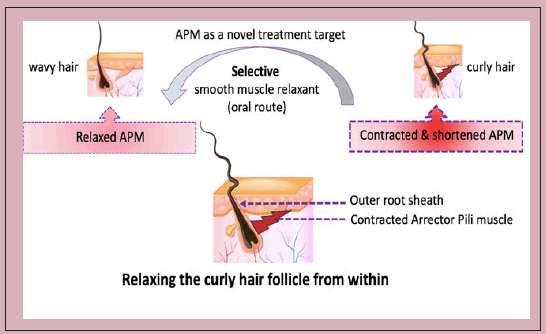
Introduction
The scalp hair consists of two domains the shaft and the Hair Follicle (HF). The human hair shaft has enormous diversity in the degree of curvature and the principle is now established that the hair shape is programmed from the follicle and that the hair fiber is a memory shape [1,2]. For many years’ cosmetic scientists have attempted to develop hair typing systems by measuring the specific physical 3D features of human hair, including qualitative hair typing system developed by Andre Walker, classifying hair into Type I-IV with subtypes (a-c) (Figure 1), later quantitative hair typing of Segmentation Tree Analysis Method (STAM) and modified-STAM classification. A high-throughput phenotyping methods study was conducted. Recently, hair science was reimagined to classify curly hair phenotypes using dynamic mechanical analyzer [3-5].
Human hair shape is programmed from the bulb with the curve of the hair is created by an internal mechanical force. At the follicular level, studies of scalp biopsies showed that the dermal implantation of curly and coily HF have a retrocurvature at the level of the bulb, the bulb itself was bent in the shape of a golf club. Both the Outer Root Sheath (ORS) and the connective tissue (dermal) sheaths were dissymmetrical. The proliferative matrix compartment of curly hair follicle was asymmetrical, Ki-67 labelled cells being more numerous on the convex side and extending above the Auber line. On the convex part of the follicle, the ORS was thinner. Furthermore, some ORS cells expressed alpha-smooth muscle actin protein on the concave side of the curvature, reflecting a mechanical stress [1].
The multilayered hair follicle architecture and hair formation
The hair follicle’s structural unit is called the pilosebaceous unit (from Latin pilus “hair”) that is comprised of the HF and its associated Arrector Pili Muscle (APM) and Sebaceous Gland (SG). The pilosebaceous unit is a complex, dynamic, 3-D structure which is the site of unique biochemical, dynamic and immunologic events. The hair follicle originates from the surface of the epidermis and extends into the deep dermis in a tunnellike structure. In cross section the HF have an onion skin structure with the hair fiber in the middle encircled by the Inner Root Sheath (IRS) and the Outer Root Sheath (ORS) that is the site of APM muscle attachment and the dermal sheath (Figure 2) [6-9].
In longitudinal section, the HF is composed of 3 segments. The inferior segment encompasses the bulb and suprabulb separated by Auber’s line. The bulb contains the follicular matrix that is actively dividing to produce keratinocytes, with the mitotic force pushing the cells upward to forms the young hair root. The middle segment is the isthmus marked by the attachment of the APM at the bulge region and extends to the entrance of sebaceous duct opening. Above the sebaceous gland is the infundibulum (Figure 3A). The young hair root is encased by the IRS that shapes the hair shaft as it keratinizes early in the hair cycle. The ORS encases the entirety of the hair shaft and keratinize around the isthmus level. Further, the HF is surrounded by the dermal sheath. The pilosebaceous unit further comprises the APM muscle and the Sebaceous Gland (SG) (Figures 3B and 3C) [8].
Figure 3: Diagrammatic representation of the multilayered hair follicle structure. This figure shows a longitudinal section of the HF. Note: A) Show the shaft at the center and the associated APM and Sebaceous Gland (SG), encircled by the IRS; B) Ensheathed by the ORS; C) Embedded in the dermis layer of the skin and the dermal sheath.
The arrector pili muscle of the hair follicle: Current state of knowledge
The Arrector Pili Muscle (APM) is a smooth muscle bundle that attaches to the bulge region of the follicle via elastic tendons and extends obliquely to its superior attachment in the upper dermis at the dermo-epidermal Basement Membrane (BM) (Figure 3A). Microscopically, one APM muscle can serve one HF and encircle its entire circumference and attaches to the BM, or multiple APMs from multiple follicles join together at the level of the isthmus and form a single muscular structure known as the follicular unit [10,11]. APM was thought to be vestigial in humans, but its known functions are piloerection (goosebumps) by contracting to mediate thermos-regulation facilitate sebum secretion and participate in follicle cycling. Hypothetically, APM have a possible role in maintaining the follicular integrity and stability. It has been observed to undergo changes during in hair loss disorders. APM was studied in abdominal wall hair follicles using X-ray micro CT to define its fundamental 3D structure since it is important for skin regeneration and cosmetics [12]. Hair growth is influenced by numerous physiologic moderators. Greater understanding of the biology of the hair follicle facilitates the development of targeted therapy. Example is sublingual minoxidil. APM was investigated mainly as underling the mechanism of hair loss (alopecia) and an emerging therapeutic target. In hair transplantation surgery, the hair is popping out of graft once the APM is cut [13-16]. The perifollicular sympathetic nerve has a nutritional and regulatory effect on the growth, development and physiologic cycle of HF. The sympathetic nerve forms a tight connection with the APM being enwrapped and penetrated by sympathetic nerve, APM provide stable anchors to the sympathetic nerve supply. Recent progress in the understanding demonstrated that the nerveeffect factor norepinephrine affects HF stem cell and growth and modulate hair stem cell activity [17]. Shaping the hair is under developmental and molecular control. The creation of the highly complex biomaterial in the HF and how these confer mechanical function on the fiber so formed is a topic that remains relatively unexplained thus far. We are still a very long way from understanding the complete biological and biophysical mechanisms that produce such a wide range of curled, coiled, kinky and wavy hair fiber [6].
Hypothesis of Hypersensitive Contracted Arrector Pili Muscle
In this hypothesis, it has been proposed that the mechanical force that curves the hair follicle and produce the micropatterns of curly or coily hair is generated by the contracted fibers of the APM squeezing its ORS attachment site at the bulge producing a zone of “APM molding and sculpting”, the attachment site become concave with different shapes and degrees of curvatures, pushing the proliferating keratinocytes away to overfill the opposite side to make it convex, deviate the axis of rotation, impact keratin filament alignment and orientation during the time of keratinization and hardening sculpturing the young hair fiber in this 3D mold producing a dissymmetrical HF and a curly/coily hair fiber (Figures 4 and 5). If this mechanical force can be relaxed by a selective smooth muscle relaxing treatment, then the curved HF will be relaxed and the curly hair fiber will be relaxed from within. The contracted APM muscle hypothesis can answer several questions the science doesn’t have the answer for-yet. This hypothesis can answer how multiple curl types are present in one textured head, why multiple 3D shapes are present within the same coil type and subtype and whether an individualized curly hair pattern is possible. In addition, it set the stage for developing a selective smooth muscle relaxing treatment.
Scientific Support for the Contracted APM Hypothesis
Diving into the general biology of smooth muscle
There are limited studies on the biology of the APM. Therefore, we dive in the general biology of the human smooth muscle to get more insight and apply this knowledge to APM.
• Smooth Muscles (SM) are found throughout the body where it serves to regulate function of internal organs. For example, in the respiratory tract it regulates the airway diameter, in the blood vessels it regulates vascular resistance, in the eye it functions as a sensory organ, dilating and constricting the pupil in response to light and in the skin where it raises the hair in response to cold weather and emotions (goosebumps).
• There are two physiologic variants of SM, a single-unit and multi-unit, wherein the single-unit can be stimulated by only one synaptic input to produce a synchronous contraction, while in the multi-unit SM each cell receives its synaptic input to allow a much finer controlled physiologic function. Multiunit SM are found in the skin (APM), the eye (ciliary muscle) and the airways. SM have the ability to be contracted and controlled involuntarily and are capable of maintain tone for extended periods. The autonomic nervous system uses hormones, neurotransmitters and other receptors to control smooth muscle contraction. The use of SM-relaxing treatment is an approach to treat hypersensitive airways and other conditions [18].
• The emotional and physiological (non-emotional) correlates of piloerection in humans were studied by [19]. Their analysis revealed that indices of sympathetic activation are abundant, suggesting emotional piloerection occurs with increased (phasic) skin conductance.
• An interesting hypothesis about SM is that they have sculpturing function on the epithelial lining of internal organs during embryonic development. Organs involved are hollow organs lined by epithelial mucous membrane stiffness over a variety of cell lengths makes SM cells especially poised for directing epithelial morphogenesis [20]. Morphogenesis is defined as a mechanical process involving force that generate mechanical stress, strain and movement of cells and can be induced by genetic programs according to spatial patterning of cells within tissues [21]. It became clear that these properties make SM an effective tool for changing the shape and lumen diameter of the internal organ lining. Furthermore, investigating how nature uses SM as a morphogenic tool may help us understand how to repurpose it for engineering organs in clinical application [20].
• Pierard-Franchimont et al., offered a hypothesis that, the hair shape in part depends on the organization of the cellproliferation in the hair matrix. This review gathers observations supporting the involvement of cell tensegrity in shaping the hair shaft. Cell tensegrity encompasses all intrinsic and extrinsic forces responsible for the three-dimensional arrangement of intracellular macromolecules [22].
How does APM Difference from other smooth muscles? personal observaions
During my study of the published articles on the morphology and function of the different types of muscles in human body that APM share some characteristics with skeletal muscles (Table 1). APM fibers are longitudinal and have origin and insertion, hence the direction of force can be to “pull upward” the follicle in the direction of the APM attachment at the dermoepidermal basement membrane. This might explain previous observations that a curly HF penetrates the epidermis at an angle, tilted in the shape of golf club with dissymmetrical follicle. The functional similarity the SM of internal organs might explain how a slow, strong contraction of APM can be sustained for a long time to create muscle tone that can sculpture the HF. This contraction is Involuntary, self-working and self-regulated.
| Skeletal | Smooth | Arrector pili | |
|---|---|---|---|
| Microscopical appearance | striated | No striation | No striation |
| Fiber orientation | Longitudinal parallel bundles | Circular branching bundles complex system | Longitudinal |
| Tendon attachment | Yes | No | Yes |
| Site of attachment | Attached to the boney skeleton | No attachment, Present in internal organ | Attached between the epidermis and hair follicle |
| Strength of contraction | Slower, stronger, sustained for long time | ||
| Direction of force | Push up | squeeze | Push up |
| Innervation, contraction and excitation | Voluntary contraction, at will | Involuntary, self-working and regulation | Involuntary, self-working and regulation |
| Sensory response | No | Yes | Yes, piloerection on exposure to cold and emotions |
Table 1: Anatomical and functional characteristics of skeletal and smooth muscle demonstrate that the arrector pili muscle shares anatomical and functional characters with skeletal muscles.
Neurologic pathways of the hypersensitive APM
Hypersensitive APM is referring to an increased response of the muscle fibers to different environmental factors including light, ultraviolet rays, heat, or other spasmogens that might be involved. The environmental factors act directly on the outer layer of the skin, the epidermis it induces a nerve impulse transmitted to the deep layer of the skin, the dermis. It has been established that dermal-epidermal interactions regulate HF activities.
• Two neural networks innervate hair and HF and both contain sensory nerve fibers and sympathetic nerve fibers that regulate involuntary physiologic processes (N1 and N2). One of the neural networks surrounds the neck of the HF and the second encircle the midsection of the HF. The APM is innervated also by the nearby nerves (Figure 4) [23].
• In a scanning electron microscopic study, it has been observed that repeated contraction of the APM produce groove-like depressions and ring -like elevations of the ORS: In the bulge area of scalp follicles there are many knob-like or villous projections either located on one side or around the entire circumference of the follicle. These projections were thought to represent the anchoring points of the branched follicular end of the arrector muscles. Ring-like elevations with groove-like depressions above and below were also observed surrounding the entire follicle. These were thought to represent the track of circum-follicular arrector muscles which depressed the ORS when they repeatedly contracted [24].
• The most amazing research inding is that the external light entering the eye stimulate the retina and can activates HF stem cells through sympathetic neural pathway [25].
• Neurotransmitters are released from axons and diffuse to the SM cells. The ability of the nerve to initiate an action potential depends on the amount of neurotransmitter released and the amount of depolarization required to reach threshold. Therefore, it is reasonable to hypothesize that an indivi-dualized response can explain the individual hair curl pattern!
New zone of APM molding of the young hair root
Hair keratinization was described as orderly series occurring at the molecular level. The hierarchical structure of the hair is alpha-keratin coiled-coil protein that form a tetramer profilaments intermediate filaments until they aggregate together to form microfilament surrounded by matrix to form the basic unit of hair cortical cell. The architecture of human hair intermediate filament was studied in relation to the longitudinal organization of the molecule within the filament, lateral interfilament packing and described “nonordered” organization inside hard alpha-keratin intermediate fibers [26]. On the other hand, curl in the hair was hypothesized to derive primarily from “inhomogenous” distribution of different cell types across the fiber cross-section as a result of subtle biochemical engineering by the follicle. Further, the gradual stiffening of the hair fiber tetramer structure over the course of the entire keratinization process was studied and the process was divided into four “zones” starting above the bulb is the elongation zone keratinization hardening concomitant with their continuous compaction and parallel orientation and post-hardening zones [27]. In our contracted APM hypothesis (Figure 6), we are proposing that there is a “zone of sculpting and molding,” where each APM muscle fibers contracts individually to create an asymmetrical 3D mold for the young soft hair root. The APM mold is located under the muscle attachment to the ORS. This mold can physically constrain the space available for the proliferating keratinocytes sufficient to produce dissymmetrical (nonordered and inhomogenous) placement of the keratinocyte and physically influence the compacting and alignment of the developing keratin filaments to produce individualized curly hair pattern. This process involves forces that generate mechanical stress, strain and movement of cells and can be induced by genetic programs according to the spatial patterning of cells within tissues.
APM as a Target to Develop New Curl Relaxing Treatment
The hypothesis set the stage to identify the structure of a smooth muscle target, including cell surfaces receptor, that is involved or upregulated and functions to induce APM contraction. If such a receptor is found, then a computer-aided in silico preliminary studies can be performed to find small molecules with the potential to modulate the activity of this receptor.
Testing the Contracted APM Hypothesis
Our hypothesis can be challenged by studying the 3- Dimesional (3D) quantitative characteristics of AMP of curly hair follicle. The 3D studies include APM volume, mean length, muscle angle with the basement membrane and its orientation. It is more informative to calculate the ratio of APM volume/ whole follicle volume in curly hair and compare it to other hair types. The technology used in published research include X-ray micro CT [12], very high-frequency ultrasound, or computerbased 3D reconstruction [28,29]. Coiled coil predictions are often used to interpret biochemical data and are part of in silico functional genome annotation [30]. Later, it is desirable to evaluate APM as a target for the development of new treatment that relax the HF using in silico computer-aided target identification.
Conclusion
We propose and try to support, the hypothesis that APM play a critical role in molding the HF and shaping the hair shaft and as a consequence propose the search for selective smooth muscle relaxing small molecules as a possible treatment to relax curly hair from within. This mechanistic hypothesis can explain why there are a wide range of hair fiber shapes, that can’t be explained on genetic studies or other hypotheses.
Highlights
• Contraction of the tiny smooth muscle of the hair follicle, the arrector pili, generates the mechanical force to curve the hair follicle into a golf club shape.
• The arrector pili is a multi-unit smooth muscle, where each fiber contract independent on the other to create the enormous diversity of hair types.
• As a smooth muscle, the arrector pili contraction can be prolonged and strong.
• The arrector pili has a sensory function it contracts in response to environmental factors as cold weather or emotion to produce goosebumps (piloerection).
• The arrector pili can be considered as a valid target to develop ingestible selective smooth muscle relaxing treatment to relax coily/curly hair from within to meet consumers’ needs and wants.
Acknowledgement
I would like to thank Noor Ahmed for assisting in the preparation and submission of this article.
References
- Thibaut S, Gaillard O, Bouhanna P, Cannell DW, Bernard BA (2005) Human hair is programmed from the bulb. Br J Dermatol 152: 632-638.
[Crossref] [Google Scholar] [Indexed].
- Thibaut S, Barbarat P, Leroy F, Bernard BA (2007) Human hair keratin network and curvature. Int J Dermatol 46: 7-10.
[Crossref] [Google Scholar] [Indexed]
- Loussouarn G, Garcel AL, Lozano I, Collaudin C (2007) Worldwide diversity of hair curliness: A new method of assessment. Int J Dermatol 46: 2-6.
[Crossref] [Google Scholar] [Indexed]
- Lasisi T, Zaidi AA, Webster TH, Stephens NB, Routch K, et al. (2021) High-throughput phenotyping methods for quantifying hair fiber morphology. Sci Rep 11: 11535.
[Crossref] [Google Scholar] [Indexed]
- Gaines M, Page I, Miller N, Greenvall BR, Medina J, et al. (2023) Reimagining hair science: A new approach to classify curly hair phenotypes via new quantitative geometrical and structural mechanical parameters. Acc Chem Res 56: 1330-1339.
[Crossref] [Google Scholar] [Indexed]
- Westgate GE, Ginger RS, Green MR (2017) The biology and genetics of curly hair. Exp Dermatol 26: 483-490.
[Crossref] [Google Scholar] [Indexed]
- Agarwal R, Katare OP, Vyas SP (2000) The pilosebaceous unit: A pivotal route for topical drug delivery. Methods Find Exp Clin Pharmacol 22:129-133.
[Crossref] [Google Scholar] [Indexed]
- Martel JL, Miao JH, Badri T, Fakoya AO (2024) Anatomy, hair follicle. StatPearls publishing, Treasure Island (FL), USA.
- Elsabe C, Khumalo N, Ngoepe MN (2019) The what, why and how of curly hair: A review. Proc Math Phys Eng Sci 475: 20190516.
[Crossref] [Google Scholar] [Indexed]
- Poblet E, Ortega F, Jimenez F (2002) The arrector pili muscle and the follicular unit of the scalp: A microscopic anatomy study. Dermatol Surg 28: 800-803.
[Crossref] [Google Scholar] [Indexed]
- Barcaui CB, Pineiro-Maceira J, Alchorne MMDA (2002) Arrector pili muscle: Evidence of proximal attachment variant in terminal follicles of the scalp. Br J Dermatol 146: 657-658.
[Crossref] [Google Scholar], [Indexed]
- Ezure T, Amano S, Matsuzaki K (2022) Quantitative characterization of 3D structure of vellus hair arrector pili muscles by micro CT. Skin Res Technol 28: 689-694.
[Crossref] [Google Scholar] [Indexed]
- Willems A, Sinclair R (2021) Alopecia in humans: Biology, pathomechanisms and emerging therapies. Vet Dermatol 32: 1-159.
[Crossref] [Google Scholar] [Indexed]
- Xu W, Wan S, Xie B, Song X (2023) Novel therapeutic target for alopecia areata. Front Immunol 14: 1148359.
[Crossref] [Google Scholar] [Indexed]
- Redmond LC, Limbu S, Farjo B, Messenger AG, Higgins CA (2023) Male pattern hair loss: Can developmental origins explain the pattern? Exp Dermatol 23: 1174-1181.
[Crossref] [Google Scholar] [Indexed]
- Garg A, Garg S (2021) Overview of follicular extraction. Indian J Plast Surg 54: 456-462.
[Crossref] [Google Scholar] [Indexed]
- Zhang J, Chen R, Wen L, Fan Z, Guo Y, et al. (2021) Recent progress in the understanding of the effect of sympathetic nerve on HF growth. Front Cell Dev Biol 9: 736738.
- Hafen BB, Shook M, Burns B (2023) Anatomy, smooth muscle. StatPearls publishing, Treasure Island (FL), USA.
- McPhetres J, Zickfeld JH (2022) The physiological study of emotional piloerection: A systematic review and guide for future research. Int J Psychophysiol 179: 6-20.
- Jaslove JM, Nelson CM (2018) Smooth muscle: A stiff sculptor of epithelial shapes. Philos Trans R Soc Lond B Biol Sci 373: 20170318.
[Crossref] [Google Scholar] [Indexed]
- Bidhendi AJ, Bara A, Frederick FP, Geitmann A (2019) Mechanical stress initiates and sustains the morphogenesis of wavy leaf epidermal cells. Cell Rep 28: 1237-1250.
[Crossref] [Google Scholar] [Indexed]
- Pierard-Franchimont C, Paquet P, Quatresooz P, Piérard GE (2011) Mechanobiology and cell tensegrity: The root of ethnic hair curling? J Cosmet Dermato 10: 163-167.
[Crossref] [Google Scholar] [Indexed]
- Murphrey MB, Agarwal S, Zito PM (2023) Anatomy, Hair. StatPearls publishing, Treasure Island (FL), USA.
- Narisawa Y, Hashimoto K, Kohda H (1995) Scanning electron microscopic observations of extracted terminal hair follicles of the adult human scalp and eyebrow with special reference to bulge area. Arch Dermatol Res 287: 599-607.
[Crossref] [Google Scholar] [Indexed]
- Mai-Yi Fan S, Chang Y, Chen C, Wang W, Pan M, et al. (2018) External light activates hair follicle stem cells through eyes via an ipRGC–SCN-sympathetic neural pathway. Proc Natl Acad Sci 115: 6880-6889:
[Crossref] [Google Scholar] [Indexed]
- Rafik MR, Doucet J, Briki F (2004) The intermediate filament architecture as determined by X-ray diffraction modeling of hard alpha-keratin. Biophys J 86: 3893-3904.
[Crossref] [Google Scholar] [Indexed]
- Bornschlögl T, Bildstein L, Thibaut S, Santoprete R, Fiat F, et al. (2016) Keratin network modification lead to mechanical stiffening of the hair follicle fiber. Proc Natl Acad Sci 113: 5940-5945.
[Crossref] [Google Scholar] [Indexed]
- Wortsman X, Carreño L, Ferreira-Wortsman C, Poniachik R, Pizarro K, et al. (2019) Ultrasound characteristics of the hair follicle and tracts, sebaceous glands, montgomery glands, apocrine glands and arrector pili muscles. J Ultrasound Med 38: 1995-2004
[Crossref] [Google Scholar] [Indexed]
- Jimenez-Acosta F, WC Song, WJ Hwang, Koh K (2006) From the literature: A new model for the morphology of the arrector pili muscle in the follicular unit based on three-dimensional reconstruction. Hair Transplant Forum International 16: 186.
- Simm D, Hatje K, Waack S, Kollmar M (2021) Critical assessment of coiled-coil predictions based on protein structure data. Sci Rep 11: 12439.
[Crossref] [Google Scholar] [Indexed]
Open Access Journals
- Aquaculture & Veterinary Science
- Chemistry & Chemical Sciences
- Clinical Sciences
- Engineering
- General Science
- Genetics & Molecular Biology
- Health Care & Nursing
- Immunology & Microbiology
- Materials Science
- Mathematics & Physics
- Medical Sciences
- Neurology & Psychiatry
- Oncology & Cancer Science
- Pharmaceutical Sciences
